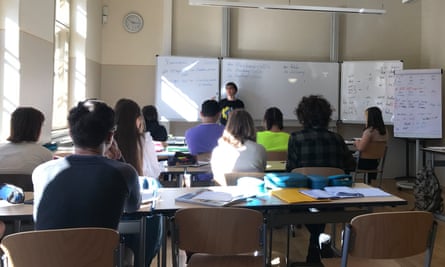A brief exchange between Liudmyla Mashkova and her pupils, in which she asks them in German to open a window because the classroom is stuffy, illustrates how far they have come. “Ja klar,” Artur Ivanov responds in the same language, and there’s a collective sigh of relief as everyone enjoys the fresh breeze.
The secondary school teacher, from Kyiv, has been leading a class of Ukrainian students, aged 12 to 17, since April. They are in Potsdam, a German city just west of Berlin, where the Helmholtz Gymnasium, or secondary school, has given them space and resources.
Mashkova has been employed to teach German in one of the thousands of willkommensklassen, or welcome classes, set up at schools across the country.
She fled the war in Ukraine at the beginning of March along with her 16-year-old son and five-year-old daughter, leaving behind her husband, an officer in the Ukrainian army.
Like her pupils, who come mainly from the south and the east of Ukraine, Mashkova had hoped for a quicker end to the war. Now they are together once again at the start of a new school year, with just a few changes to the class makeup.
There are a couple of newcomers and some pupils from the Kyiv region who texted her over the six-week break to let her know they had returned home.
One of their first discussions on arriving back after the summer break was to check up on their families, and she recalls the relief she felt on hearing that “nothing dramatic” had happened to them.
“We’re in this together. I’m here to help them but we’re all in a similar situation, making the best of it, and for the most part actually able to see it as a positive experience,” Mashkova says. “We have little choice.”

Hers are among more than 150,000 school-age children who have arrived in Germany since the start of the Russian invasion and are being integrated into the school system. Mashkova is one of many Ukrainian teachers who are vital to the effort, not least because of a shortage of about 30,000 German teaching staff.
Opinions differ as to the best way to educate them. German authorities are modelling the accommodation of young Ukrainians on the experience from 2015, when almost 1 million refugees arrived from Syria.
Back then the willkommesklassen were introduced with the goal of teaching the new arrivals German and preparing them for eventual transfer into regular classes.
The Ukrainian consul general, Iryna Tybinka, however, has been insistent that Ukrainian children should be able to continue with their native school curricula, due to what she has called the temporary nature of their stay.
Mashkova recognises the strong motivation among her pupils and their parents, with whom she is in close contact, to return home as soon as possible. But there is also realism a keenness to learn German, in part due to the recognition that they might be there for the next two years at least.
Artur Ivanov, 14, from Odesa, who already spoke some German when he arrived on 18 March, insists he has no plans to return to Ukraine. “My parents have found work. It’s better for us to build a new life here,” he says.
He already attends music, PE, art and maths classes with German pupils. But he is looking forward to getting his German up to “B1 level” – “hopefully by January” – so that he can permanently join a regular class.
Kate Pavlenko, from Kharkiv, arrived five months ago with her mother and pets, Robin the dog and Krosha the parrot. She describes the experience of being in Germany in her basic but solid German, as “good, interesting and safe”.
Kate and her classmate Daria Ilnytstka, from Kyiv, could take extra online classes offered by their teachers in Ukraine after their German school day is over. Instead the 13-year-old friends take the tram to Potsdam’s Montelino circus school where they’ve been able to resume the acrobatics they practised in Ukraine.

“Next to my family and friends it’s the most important thing I have here,” Daria says, describing how she spent the summer holidays learning the art of aerial silks.
“I’m keen to get out of this experience as much as I can,” says Ksennia Okulova, 15, who is enjoying “learning German and getting to know the culture” and appreciates being in a class with other Ukrainians for the time being.
The students can share their experiences and feelings that German pupils might not understand, she says – from living in a shipping container, where she has been since her arrival in April, to the progress of Ukraine’s army.
Her friend from home, Sebastian Kohan, who followed her to Potsdam, wears his grandfather’s signet ring on a chain around his neck – a gift from his father who is working with the army, which he says keeps him close to him.
“It’s a relief to be here even if it takes a while to get used to the German way of life,” he said. “They go to sleep very early and we have to be very quiet in the mornings and the evenings. There are lots of rules. But they are also very tolerant of each other. I feel that here you can be who you want to be.”
Sebastian’s cat, Watson, is being looked after by another family for now as the place where he is living doesn’t allow pets. “We hope we’ll get him back soon,” he says.
